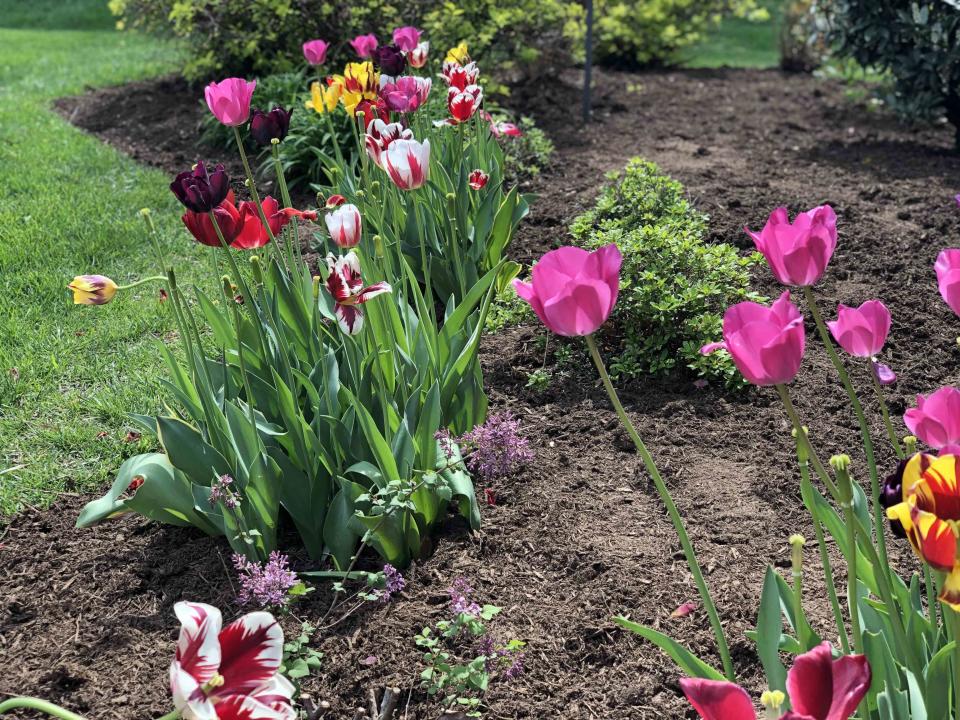How Much Mulch Do You Need for Your Garden?
You're going to have to do a little math to find your magic number.

KPD Images/Getty Images
Why You Need Mulch for Your Garden
Mulch does a lot more than create an aesthetically pleasing backdrop for your favorite garden plants. It can help keep weeds from growing and disrupting your garden plants, and keep your garden soil from drying out, reducing the need for watering. It's also beneficial for protecting your plants from temperature extremes (more important than ever these days!).
Types of Mulch to Use
You have several options of mulch to consider, depending on where and how you'd like to use your mulch. Generally, they fall into two categories—organic mulches and inorganic mulches.
Organic mulch
Organic mulch like wood chips or bark are most commonly used, but you could also use shredded leaves, grass clippings, or pine needles. In addition to protecting your plants and smothering weeds, organic matter starts to decompose into the soil, helping enrich your garden.
Organic mulches tend to be less expensive than their inorganic counterparts, but also need to be reapplied more often as they decompose or wash away.
Inorganic mulch
Inorganic mulches are things that won't decompose, and so they typically last longer in your landscape. They can also tend to attract and hold in heat, so they tend to work best in shaded areas of the garden.
Stone or gravel mulch is a great option on slopes and inclines, where it can help keep water from washing away your soil—and they're also used in areas prone to wildfires, as they won't become a potential fuel for a fire.
Other inorganic options include seashells, rubber mulch, marble chips, and even recycled tumbled glass.
Related: How to Xeriscape Your Garden
Inorganic mulches tend to be a bigger investment, but they require fewer replacements.
How Deep Should the Mulch Be?
When you're applying mulch, you need to find the balance between too little and too much mulch. Too little mulch won't offer the same protections against weeds, moisture loss, and temperature extremes, while too much can develop mold or rot.
Related: 6 Things You Can Do Right Now for a Gorgeous Yard This Summer
Generally, a mulch depth of about three to four inches is ideal, with less if it's a smaller, more granular mulch, and more if it's a larger mulch.
How to Calculate How Much Mulch You Need
To calculate how much mulch you need, measure the length and width of your garden bed in feet, then multiply those numbers and divide by three. That'll tell you exactly how many cubic feet of mulch you'll need to cover the area with a four-inch layer.
Before you invest in a lot of mulch, you should double check the manufacturer's recommendations. Some mulch types may not need to be as deep to provide the same level of protection for your garden.
How Often to Replenish Your Mulch
Generally, you'll need to add more organic mulch to your gardens once a year, usually in spring.
Check your mulch in the fall
If you live in colder climes, check your mulch levels in the fall, and top off as needed. Extra mulch can help protect your plant roots from extremely cold temperatures.
You may want to assess how much mulch remains from the previous year, as you may only need to top off by an inch or so in some areas of your garden.
Inorganic mulch tends to stay in place and won't decompose, so you'll likely be able to go five years before you need to replenish.
Related: How to Start a Garden in 10 Steps
How to Apply Mulch to Your Garden
To apply mulch, start by making sure your garden bed is in tip-top shape. Clear out any weeds and plant any new plants that you need to add.
If you're applying an inorganic mulch, you may want to include a layer of landscape fabric—not plastic—to help reduce weeds. Apply the mulch to the desired depth using a shovel and a rake, taking care to keep the mulch away from your plants' stems and leaves to protect them from potential pests.
A light watering will help set your mulch and keep it in place. If you are concerned about mulch ending up on your lawn or washing away, you can use stones, treated lumber, or garden bed edging to help keep it in place.
For more Real Simple news, make sure to sign up for our newsletter!
Read the original article on Real Simple.


